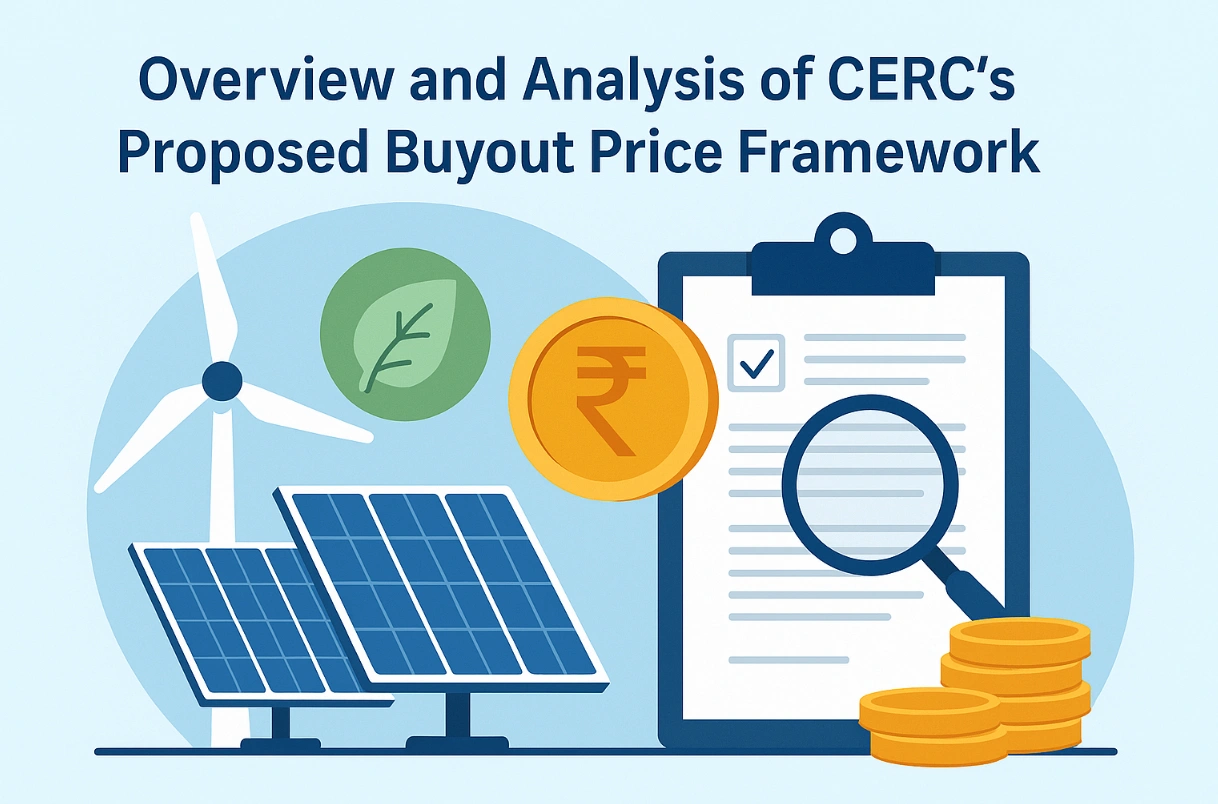Overview and Analysis of CERC’s Proposed Framework on Buyout Price for RCO Compliance

By – Aditya Pratap Singh
Table of Contents
The Central Electricity Regulatory Commission (“CERC”) has recently issued a suo motu proposal to determine the Buyout Price as an alternate compliance mechanism under the Renewable Consumption Obligation (“RCO”). The proposal has been issued in continuation of the Ministry of Power (“MoP”) notification dated 27.09.2025, which specifies the minimum share of renewable energy that must be consumed by distribution licensees, open access consumers, and captive users1.
Background and Context
The RCO framework requires designated entities to ensure that a prescribed portion of their total electricity consumption is sourced from renewable and other non-fossil fuel-based sources, thereby supporting India’s national goal of achieving 500 GW of installed non-fossil fuel energy capacity by 2030
CERC’s proposal focuses on defining the operational details of the Buyout mechanism, which is one of the three routes available for RCO compliance. It explains how the Buyout Price will be calculated and how the funds collected through this mechanism will be utilized. The proposal also clarifies the relationship between the Buyout option and the other two routes direct consumption of renewable power and purchase of Renewable Energy Certificates (“RECs”) under the broader RCO framework.
The Renewable Consumption Obligation (RCO) Framework
The Renewable Consumption Obligation was introduced by the MoP to establish clear and measurable renewable energy consumption targets for key categories of electricity consumers. The MoP notification dated 27.09.2025 provides that every designated consumer must meet a specified percentage of its total electricity consumption from renewable sources, thereby ensuring steady demand for renewable energy across the country.
Three Routes for Compliance
To achieve their RCO targets, designated consumers have been given three compliance routes:
- First, they may fulfil their obligation through direct consumption of renewable electricity, either procured directly or through an energy storage system. This represents the most direct and impactful mode of compliance, as it leads to actual renewable generation and investment in green infrastructure.
- Second, consumers may purchase or self-generate Renewable Energy Certificates (“RECs”). Each REC represents proof that one megawatt-hour of electricity has been generated from renewable sources. Buying RECs allows entities to meet their renewable targets even if they cannot physically procure green power, thereby helping maintain liquidity and market-based compliance flexibility.
- Third, and as a last resort, entities may comply through payment of a Buyout Price specified by CERC. The Buyout Price represents a monetary contribution towards renewable energy development for those unable to meet their RCO through direct renewable purchase or REC acquisition.
The funds collected through the Buyout mechanism will be deposited into the Central Energy Conservation Fund (“CECF”). From there, 75 percent of the amount will be transferred to State Energy Conservation Funds (“SECFs”), which will use these sums to promote renewable energy projects and energy storage capacity.
Thus, RCO framework provides designated entities with multiple options for meeting their obligations, while also ensuring that payments made under the Buyout mechanism are used to support renewable energy and energy storage initiatives.
CERC’s Proposal on the Buyout Price Mechanism
Following the Ministry’s notification, the CERC has, through proposal dated 22.10.2025 in Petition No. 12/SM/2025, proposed a detailed framework for determining the Buyout Price2. The purpose of this mechanism is to provide an alternate route for RCO compliance during periods when renewable electricity or RECs are unavailable or insufficient in the market.
In its proposal, CERC has emphasised that direct consumption of renewable electricity and purchase of RECs must remain the preferred options for compliance, as they directly support renewable capacity growth. The Buyout mechanism is to be treated only as a fallback option, to be used in exceptional cases where the first two routes cannot be met.
Purpose and Scope of the Proposal
Recognising that India’s current renewable capacity and annual capacity additions may not immediately be sufficient to meet all RCO requirements, CERC has acknowledged that some consumers may temporarily need to rely on the Buyout mechanism, particularly over the next two financial years.
To ensure fairness while maintaining a clear incentive for renewable procurement, the Commission has proposed that the Buyout Price be linked to the market value of RECs, with a small premium to discourage overuse of this route. CERC reasoned that since the REC price already represents the cost of the “green attribute” of renewable power, the Buyout Price should be slightly higher to ensure that the Buyout remains the least attractive compliance option.
Proposed Calculation Method and Formula
Based on actual REC transaction data from FY 2024–25, CERC observed that RECs were traded at a weighted average price of ₹232.84/MWh. On power exchanges, the average price stood at ₹225.36/MWh, while transactions through trading licensees averaged ₹291.32/MWh. Using these values, CERC proposed the Buyout Price for FY 2024–25 at ₹245/MWh, representing a 5% premium over the weighted average REC price.
For subsequent years, up to FY 2029–30, the Commission has proposed a formula-based approach, the Buyout Price for each financial year shall be fixed at 105% of the weighted average REC price of the previous year. The National Load Despatch Centre (“NLDC”) will be responsible for calculating and publishing these prices annually by 30 April, based on verified REC transaction data.
Treatment and Allocation of Buyout Funds
In addition, CERC has explained that the Buyout Price represents the value of the renewable attribute, and entities opting for this option will continue to procure their electricity separately for meeting their consumption requirements.
The Commission has also reiterated that all funds received through the Buyout mechanism will be credited to the Central Energy Conservation Fund, and 75% of these proceeds will be transferred to State Energy Conservation Funds for utilisation towards renewable energy and storage development.
CERC has invited comments, suggestions, and objections from stakeholders on the proposal by 21.11.2025. The submissions may be sent to The Secretary, Central Electricity Regulatory Commission, 6th–8th Floors, Tower B, World Trade Centre, Nauroji Nagar, New Delhi – 110029, or by email to secy@cercind.gov.in and advisor-re@cercind.gov.in After considering the feedback received, the Commission will issue a final order formalising the Buyout Price mechanism for RCO compliance.
Critical Analysis and Key Gaps in the Proposal
While the CERC proposal provides a structured and transparent method for determining the Buyout Price, certain conceptual and practical issues emerge upon closer analysis. These merit further examination before the framework is finalised :
Effectiveness in Promoting Renewable Capacity
The first issue concerns the effectiveness of the Buyout mechanism in promoting actual renewable capacity. The first two compliance routes of direct renewable consumption and REC purchase directly support renewable investment. They lead to real generation, create demand for green power, and provide financial returns to renewable producers. The Buyout mechanism, however, is different in character. It serves as a compensatory or penalty-like payment, allowing entities to achieve compliance without contributing to physical renewable deployment. Although part of the funds collected will be channelled to conservation funds, the link between payment and capacity creation is indirect and uncertain. This reduces the mechanism’s alignment with the primary goal of expanding renewable generation.
Conditions for Availing the Buyout Option
A second aspect that may warrant further clarification concerns the conditions under which the Buyout mechanism can be availed. While the CERC proposal identifies it as a fallback option, it does not specify how a designated entity is to demonstrate that it has made prior efforts to comply through renewable procurement or REC purchase. In the absence of a defined verification process, there may be uncertainty in implementation and variation in how compliance is assessed across entities.
To promote both regulatory consistency and operational flexibility, the final framework may outline the circumstances in which the Buyout option can be exercised, together with indicative criteria for establishing reasonable efforts under the first two compliance routes. This would help ensure that the Buyout mechanism functions as a supplementary compliance avenue, available when renewable procurement or REC purchase is genuinely constrained while preserving the overall incentive to source electricity from renewable sources.
Utilisation and Transparency of Buyout Funds
Another important issue relates to the utilisation and accountability of the Buyout funds. While CERC has stated that 75% of the funds will be transferred to the respective State Energy Conservation Funds, the proposal does not provide clear guidance on how these funds will be used or monitored. To promote transparency and ensure that the funds serve their intended purpose, CERC and the Ministry of Power may consider requiring each State Fund to publish annual reports detailing the utilisation of these proceeds, including the renewable energy or storage projects supported through them.
Conclusion
The CERC’s proposal on the Buyout Price under the Renewable Consumption Obligation is a constructive step toward implementing the RCO framework and providing compliance flexibility to obligated entities. It appropriately recognises current constraints in renewable energy and REC availability while reinforcing that direct renewable consumption should remain the primary mode of compliance.
For effective implementation, the final framework may clearly set out the conditions under which the Buyout option can be exercised, the manner in which efforts under the first two routes are to be demonstrated, and the process for transparent utilisation of the collected funds by the State and Central Energy Conservation Funds. Clarity on these aspects will help ensure that the Buyout operates as a limited and balanced compliance mechanism, consistent with the overall objective of promoting renewable generation and consumption.
FAQs
-
What is the Renewable Consumption Obligation (RCO) in India?
The Renewable Consumption Obligation (RCO) requires designated consumers under the Energy Conservation Act, 2001, to source a defined share of their total electricity consumption from renewable or other non-fossil fuel-based energy sources, as notified by the Ministry of Power. The framework aims to drive demand for clean energy and support India’s national renewable capacity targets.
-
What are the three compliance routes under the RCO framework?
Designated entities can comply with the Renewable Consumption Obligation (RCO) through three routes. The first is direct consumption of renewable electricity, either procured from renewable generators or supplied through energy storage systems. The second route involves the purchase or self-generation of Renewable Energy Certificates (RECs), which serve as proof of renewable energy generation when direct procurement is not feasible. The third and final option, meant as a fallback, is the payment of a Buyout Price as determined by the Central Electricity Regulatory Commission (CERC). This mechanism allows entities to fulfil their RCO requirements when renewable power or RECs are unavailable, though it is designed to be a last-resort option to ensure that direct renewable procurement remains the primary mode of compliance.
-
What is the Buyout mechanism proposed by CERC?
The Buyout mechanism proposed by the Central Electricity Regulatory Commission (CERC) provides an alternate compliance route. It allows obligated entities to pay a fixed Buyout Price instead of procuring renewable energy or RECs when such options are not feasible, ensuring continued compliance with the RCO.
-
How is the Buyout Price for RCO calculated?
CERC has proposed that the Buyout Price be fixed at 105% of the weighted average REC price of the preceding financial year. For FY 2024–25, the proposed rate is ₹245 per MWh, based on the REC trading data for FY 2024–25.
-
Why has CERC proposed a 5% premium over REC prices?
The 5% premium ensures that the Buyout option remains less attractive than purchasing RECs or procuring renewable energy directly. This maintains the financial incentive for entities to prioritise genuine renewable consumption rather than opting for the Buyout as a routine alternative.
-
What role do RECs play in RCO compliance?
RECs represent proof that one megawatt-hour of electricity has been generated from renewable sources. They enable obligated entities to meet their RCO targets even when direct renewable supply is not accessible, creating a market-based mechanism that complements renewable energy procurement.
-
How will the Buyout funds be used by CECF and SECF?
Funds collected under the Buyout mechanism will be deposited into the Central Energy Conservation Fund (CECF). Of this, 75% will be transferred to State Energy Conservation Funds (SECFs) to finance renewable energy and energy storage initiatives. However, the proposal currently does not outline a clear process for tracking or reporting how these funds are spent.
-
What are the concerns with the current Buyout proposal?
While the proposal provides a structured formula for determining the Buyout Price, it lacks clarity on the specific circumstances under which entities can invoke the Buyout option. There is also no defined process for verifying that an entity has first attempted compliance through renewable procurement or REC purchase, which may result in inconsistent application across states.
-
How does the Buyout mechanism affect renewable capacity growth?
If implemented without adequate safeguards, the Buyout mechanism may have limited impact on expanding renewable capacity. Since it allows compliance through monetary contribution rather than actual renewable generation, it must remain a fallback route. Direct renewable procurement and REC purchases should continue to be the primary compliance pathways to drive real capacity addition.
-
What feedback has CERC sought from stakeholders on this proposal?
CERC has invited comments, suggestions, and objections from stakeholders on the proposed Buyout mechanism until 21 November 2025. Submissions may be sent to the Commission’s Secretary at its New Delhi office or via email to secy@cercind.gov.in and advisor-re@cercind.gov.in before the final framework is notified.
References –
- Ministry of Power, Notification No. S.O. 4421(E) issued in exercise of the powers conferred by clauses (n) and (x) of Section 14 of the Energy Conservation Act, 2001 (52 of 2001), dated 27 September 2025.
- CERC, Proposal dated 22.10.2025 in Petition No. 12/SM/2025 for Determination of the Buyout Price as an alternate compliance mechanism towards fulfilment of Renewable Consumption Obligation (RCO).


